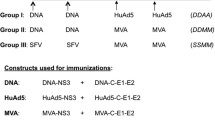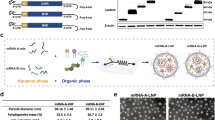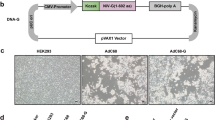Abstract
Background
Attempts to optimize DNA vaccines in mice include using different routes of administration and different formulations. It may be more relevant to human use to carry such studies out in nonhuman primates. Here we compare different approaches to delivery of a DNA vaccine against the hepatitis B virus (HBV) in Aotus monkeys.
Materials and Methods
Thirty-two adult Aotus l. lemurinus monkeys divided into 8 groups of four were immunized with 400 µg of a DNA vaccine which encoded hepatitis B surface antigen (HBsAg). DNA in saline was administered by intradermal (ID) or intramuscular (IM) injection with needle and syringe, IM injection with the Biojector® needleless injection system or combined ID (needle) and IM (Biojector). DNA formulated with cationic liposomes (CellFECTIN)® was injected IM with needle or Biojector. DNA with added E. coli DNA (100 µg) was injected IM with the Biojector or ID. A ninth group of 4 monkeys was injected IM (needle) with Engerix-B, a commercial vaccine containing recombinant HBsAg (10 µg) adsorbed onto alum. Monkeys were boosted in an identical fashion to their prime at 8 weeks, but all received the protein vaccine (Engerix-B) at 16 weeks. Sera was assessed for antibodies against HBsAg (anti-HBs) by enzyme-linked imunosorbent assay (ELISA).
Results
The primary humoral response induced by IM delivery of the DNA vaccine was very poor. In most cases there was no detectable anti-HBs even after 2 DNA doses but the kinetics of the response to subsequent protein indicated that a memory B cell response had been induced. In contrast, following IM-adrninistration of DNA using the Biojector, detectable anti-HBs were observed in 3 of 8 animals and evidence for immunological priming was apparent in an additional 4 of the 8 monkeys. ID injection of DNA vaccine in saline induced a potent antibody response which was augmented 6-fold by the addition of E. coli DNA. Combining ID and IM administration did not improve humoral immunity over ID injection alone.
Conclusions
For immunization of primates with DNA vaccines, ID may be a preferable route to IM, although it is not clear whether the Aotus monkey is a relevant model for humans in this respect. Nevertheless, the use of the Biojector needleless injection system may improve responses with IM delivery of DNA vaccines. As well, the immunostimulatory action of E. coli DNA may be used to augment the humoral response induced by a DNA vaccine.


Similar content being viewed by others
References
Donnelly JJ, Ulmer JB, Shiver JW, Liu MA. (1997) DNA vaccines. Ann. Rev. Immunol. 15: 617–648.
Davis HL, Brazolot Millan CL. (1998) DNA-based immunization. Blood Cell Biochem. (in press).
Donnelly JJ, Ulmer JB, Liu MA. (1998) DNA vaccines. Life Sci. 60: 163–172.
Gregoriadis G, Saffie R, de Souza JB. (1997) Liposome-mediated DNA vaccination. FEBS Lett. 402: 107–110.
Boyer JD, Ugen KE, Wang B, et al. (1997) Protection of chimpanzees from high-dose heterologous HIV-1 challenge by DNA vaccination. Nature Med. 3: 526–532.
Davis HL, McCluskie MJ, Gerin JL, Purcell RH. (1996) DNA vaccine for hepatitis B: Evidence for immunogenicity in chimpanzees and comparison with other vaccines. Proc. Natl. Acad. Sci. U.S.A. 93: 7213–7218.
Fuller DH, Murphey-Corb M, Clements J, Barnett S, Haynes JR. (1996) Induction of immunodeficiency virus-specific immune responses in rhesus monkeys following gene gun-mediated DNA vaccination. J. Med. Primatol. 25: 236–241.
Lekutis C, Shiver JW, Liu MA, Letvin NL. (1997) HIV-1 env DNA vaccine administered to rhesus monkeys elicits MHC class II-restricted CD4+ T helper cells that secrete IFN-gamma and TNF-al-pha. J. Immunol. 158: 4471–4477.
Liu MA, Yasutomi Y, Davies M-E, et al. (1996) Vaccination of mice and nonhuman primates using HIV-gene-containing DNA. In: Giraldo G, Bolognesi GP, Salvatore M, Beth-Giraldo E (eds). Development and Applications of Vaccines and Gene Therapy in AIDS. vol. 48. Karger, Basel, pp. 100–104.
Liu MA, McClements W, Ulmer JB, Shiver J, Donnelly J. (1997) Immunization of non-human primates with DNA vaccines. Vaccine 15: 909–912.
Lu S, Arthos J, Montefiori DC, et al. (1996) Simian immunodeficiency virus DNA vaccine trial in macaques. J. Virol. 70: 3978–3991.
Prince AM, Whalen R, Brotman B. (1997) Successful DNA-based HBV immunization of newborn chimpanzees. Vaccine 15: 916–919.
Centers for Disease Control. (1987) Recommendations of the Immunization Practises Advisory Committee. Update on hepatitis B prevention. MMWR Morb. Mortal. Wkly. Rep. 36: 353.
Calandra GB, West DJ. (1993) Recommendations for prevention of hepatitis B with vaccine. In: Ellis RW (ed). Hepatitis B Vaccines in Clinical Practice. Marcel Dekker, Inc., New York, pp. 1–16.
Davis HL. (1996) DNA-based vaccination against hepatitis B virus. Adv. Drug Delivery 21: 33–47.
Guan R. (1989) Comparison of the immunogenicity of the 5 µg dose and 10 µg dose MSD rDNA hepatitis B vaccine (Hepavac II). Epidemiol. News Bull. 15: 24–26.
Gramzinski RA, Maris DC, Obaldia N, et al. (1996) Optimization of antibody responses of a malaria DNA vaccine in Aotus monkeys. Vaccine Res. 5: 173–183.
Gramzinski RA, Maris DC, Doolan D. et al. (1997) Malaria DNA vaccines in Aotus monkeys. Vaccine 15: 913–915.
Jiao S, Williams P, Berg RK, et al. (1992) Direct gene transfer into nonhuman primate myofibers in vivo. Hum. Gene Ther. 3: 21–33.
Yasutomi Y, Robinson HL, Lu SS, et al. (1996) Simian immunodeficiency virus-specific cytotoxic T-lymphocyte induction through DNA vaccination of rhesus monkeys. J. Virol 70: 678–681.
Davis HL, Michel ML, Mancini M, Schleef M, Whalen RG. (1994) Direct gene transfer in muscle with plasmid DNA for the purpose of nucleic acid immunization. Vaccine 12: 1503–1509.
Doe B, Selby S, Barnett J, Baenziger J, Walker CM. (1996) Induction of cytotoxic T lymphocytes by intramuscular immunization with plasmid DNA is facilitated by bone marrow-derived cells. Proc. Natl. Acad. Sci. U.S.A. 93: 8578–8583.
Corr M, Lee DJ, Carson DA, Tighe H. (1996) Gene vaccination with naked plasmid DNA: Mechanism of CTL priming. J. Exp. Med. 184: 1555–1560.
Ulmer JB, Deck RR, DeWitt CM, Donnelly JJ, Liu MA. (1996) Generation of MHC class-I restricted T lymphocytes by expression of a viral protein in muscle cells: antigen presentation by non-muscle cells. Immunology 89: 59–67.
Iwasaki A, Torres CAT, Ohashi P, Robinson HL, Barber BH. (1997) The dominant role of bonemarrow derived cells in CTL induction following plasmid DNA immunization at different sites. J. Immunol. 159: 11–14.
Manickan E, Kanangat S, Rouse RJ, Yu Z, Rouse BT. (1997) Enhancement of immune response to naked DNA vaccine by immunization with transfected dendritic cells. J. Leukoc. Biol. 61: 125–132.
Condon C, Watkins SC, Celluzzi CM, Thompson K, Falo LD. (1996) DNA-based immunization by in vivo transfection of dendritic cells. Nature Med. 2: 1122–1128.
McCluskie MJ, Davis HL (1998) DNA-based immunization of mice against HBV by intramuscular injection requires free DNA. In: Brown F, Burton D, Doherty P, Mekalanos J, Norrby E (eds). Vaccines 97: Molecular Approaches to the Control of Infectious Diseases. Cold Spring Harbour Laboratory Press, New York, pp. 125–130.
Wolff JA, Malone RW, Williams P, et al. (1990) Direct gene transfer into mouse muscle in vivo. Science 247: 1465–1468.
Krieg AM, Yi A-K, Matson S, et al. (1995) CpG motifs in bacterial DNA trigger direct B-cell activation. Nature 374: 546–549.
Klinman DM, Yamshchikov G, Ishigatsubo Y. (1997) Contribution of CpG motifs to the immunogenicity of DNA vaccines. J. Immunol. 158: 3635–3639.
Sato Y, Roman M, Tighe H, et al. (1996) Immunostimulatory DNA sequences necessary for effective intradermal gene immunization. Science 273: 352–354.
Roman M, Martinorozco E, Goodman S, et al. (1997) Immunostimulatory DNA sequences function as T helper-1-promoting adjuvants. Nature Med. 3: 849–854.
Davis HL, Weeratna R, Waldschmidt TJ, Schorr J, Krieg AM. (1998) CpG DNA is a potent adjuvant in mice immunized with recombinant hepatitis B surface antigen. J. Immunol. 160: 870–876.
Gribaudo G, Ravaglia S, Caliendo A, et al. (1993) Interferons inhibit onset of murine cytomegalovirus immediate-early gene transcription. Virology 197:303–311.
Harms JS, Splitter GA. (1995) Interferon-gamma inhibits transgene expression driven by SV40 or CMV promoters but augments expression driven by the mammalian MHC I promoter. Hum. Gene Ther. 6: 1291–1297.
Cowdery JS, Chace JH, Yi A-K, Krieg AM. (1996) Bacterial DNA induces NK cells to produce interferon- γin vivo and increases the toxicity of lipopolysaccharide. J. Immunol. 156: 4570–4575.
Halpern MD, Kurlander RJ, Pisetsky DS. (1996) Bacterial DNA induces murine interferon-γ production by stimulation of interleukin-12 and tumor necrosis factor-α. Cell Immunol. 167: 72–78.
Acknowledgments
The authors thank Dr. Georg Widera (PowderJect Inc.) for providing the pCMVA-S plasmid. Dr. Arthur Krieg (University of Iowa) for the E. coli DNA, Dr. Richard Stout (Bioject Inc.) for the Biojector needleless jet injection system, and Dr. Robert H. Purcell (NIAID, NIH) for the anti-New World monkey antibody. The Gorgas Memorial Laboratory authors in Panama thank Ms. G. Cisneros for laboratory technical assistance, Mr. C. Marin, Mr. R. Rojas, and Mr. T. Gonzales for their assistance in animal handling and care, and Ms. M. Brewer for her secretarial assistance. Technical assistance was also provided in Canada by Lacrimioara Comanita and Amanda Boyd.
This work was supported by the Naval Medical Research Institute and Development Command, work units 611102A.S13.00101-BFX. 1431 and 612787A.870.00101.EFX.1432, Army Contract DAMD17-91-C-1072. Support to H. L. D. was also provided through operating grants from MRC (Canada), a travel grant from Bioject Inc., and an Ontario Ministry of Health Career Scientist Award. The experiments reported here were conducted according to the principles set forth in the Guide for the Care and Use of Laboratory Animals, Institute of Laboratory Animal Resources, National Research Council (U.S. Department of Health and Human Services, Publ. National Institutes of Health 86–23, 1985). The opinions and assertions herein are of the authors and are not to be construed as official or as reflecting the views of the U.S. Navy or the Department of Defense.
Author information
Authors and Affiliations
Corresponding author
Rights and permissions
About this article
Cite this article
Gramzinski, R.A., Brazolot Millan, C.L., Obaldia, N. et al. Immune Response to a Hepatitis B DNA Vaccine in Aotus Monkeys: A Comparison of Vaccine Formulation, Route, and Method of Administration. Mol Med 4, 109–118 (1998). https://doi.org/10.1007/BF03401734
Accepted:
Published:
Issue Date:
DOI: https://doi.org/10.1007/BF03401734




